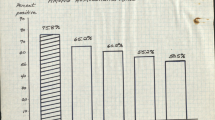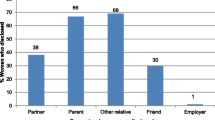Abstract
Women at risk for human immunodeficiency virus (HIV) infection are often poor and members of racial or ethnic minorities. In addition to legal concerns that might be common among persons with similar sociodemographic characteristics, HIV infection adds the potential of possible stigma and discrimination, as well as the prospect of illness and increased mortality. To determine women's perceptions of need for and access to legal services and whether such perceptions are affected by HIV infection, from November 1993 through September 1995 we interviewed 509 women with or at risk for HIV infection by virtue of injection drug use or high-risk sexual behaviors in New York and Baltimore, Maryland. A majority of women, regardless of HIV serostatus, reported current or future needs for legal assistance with government benefits. More than 25% reported needing current or future legal help with housing, debts, arrangements for care of children, a will, and advance directives. Substantial minorities of women reported other legal needs. HIV-positive women were significantly more likely to report anticipated future need for help with paternal custody or visitation, current need in making a will, and anticipated future assistance with advance directives. For most items, a majority of women thought they knew where to receive help. However, among women reporting a current need, only a minority actually were receiving legal assistance. This study suggests that the extent of legal needs among women with or at risk for HIV infection is substantial, and that few receive legal assistance. With few exceptions, at least for women early in the course of illness, HIV infection does not appear to alter the pattern or extent of legal needs. There are dramatic differences, regardless of HIV status, between expectation and reality in women's access to legal services.
Similar content being viewed by others
References
Worth D. Women at high risk of HIV infection: behavioral, prevention and intervention aspects. In: Ostrow DG, ed.Behavioral Aspects of AIDS New York, NY: Plenum; 1990: 101–118.
Special issue 1991. Poverty comes home: Women and children in the 90s.Clearinghouse Rev., 1991;25:336–466.
Farmer F. Women, poverty and AIDS. In: Farmer F, Connors M, Simmons JM, eds.Women, Poverty and AIDS: Sex, Drugs and Structural Violence, Monroe, ME: Common Courage Press, Partners in Health; 1996:3–38.
Zavos M. Women in the shadow of AIDS.Human Rights. 1992;19:18–30.
Zavos M. Legal considerations. In: Binghamton KA, ed.Until the Cure: Caring for Women with HIV. Binghamton, NY: Vail-Ballou Press, Yale University; 1993:125–143.
Zuckerman C, Gordon L. Meeting the psychosocial and legal needs of women with AIDS.NY State J Med. 1988;88:619–620.
Malaspina A. Legal aids: a New York legal program helps plan futures for children of mothers with AIDS.Student Lawyer. 1992;20:16–18.
Herb A. Standby guardianship: a viable legal option for the future care of children.J Am Med Womens Assoc. 1995;50:95–98.
Robinson RP, Monk E, Coon L, Blanford C, Mason S. Social catastrophe: orphaned by AIDS.JAMA. 1993;269:1942.
Rosenfeld S. Developments in custody options for HIV-positive parents.Berkeley Women's Law J. 1996;11:194–199.
Weimer D. Implementation of standby guardianship: respect for family autonomy.Dickinson Law Rev. 1995;100:65–102.
Crockett PH.HIV law: a survival guide to the legal system for people living with HIV. New York, NY: Three Rivers Press; 1997.
Herb A. The hospital-based attorney as patient advocate.Hastings Cent Rep. 1995;25:13–20.
Shapiro L. Legal concerns of women with HIV infection. In: Kelly P, ed.Primary Care of Women and Children with HIV Infection: a Multidisciplinary Approach. Boston, MA: Jones and Bartlett; 1995:259–271.
Stein TJ.The Social Welfare of Women and Children with HIV and AIDS: Legal Protections, Policy and Programs. New York, NY: Oxford University Press; 1998.
Viinikka S. Legal concerns of women with HIV or AIDS. In: O'Sullivan S, Thompson K, eds.Positively Women: Living with AIDS. London: Pandora/Harper Collins; 1996: 203–208.
Rubenstein WB, Eisenberg R, Gostin, LO, eds.The Rights of People Who Are HIV Positive: an American Civil Liberties Union Handbook. Carbondale, IL: Southern University Press; 1996.
Andrews LJ, Novick LB.HIV Care: a Comprehensive Handbook for Providers. Thousand Oaks, CA: Sage; 1995:141–144.
Sarmiento MT. Symposium commentary, women and HIV: breaking the silence. The legal needs of women with HIV.Berkeley Women's Law J. 1994;9:155–161.
Smith DK, Warren DL, Vlahov D, et al. Design and baseline participant characteristics of the human immunodeficiency virus epidemiology research (HER) study: a prospective cohort study of human immunodeficiency virus infection in US women.Am J Epidemiol. 1997;146:459–469.
Lather P, Smithies C. I don't know how to file away that this has happened to us. In: Lather P, Smithies C, eds.Troubling the Angels: Women Living with HIV/AIDS Boulder, CO: Westview; 1997:124
Jenkins SR, Coons HL. Psychosocial stress and adaptation processes for women coping with HIV/AIDS. In: O'Leary A, Jemmott LS, eds.Women and AIDS: Coping and Care. New York, NY: Plenum; 1996:33–86.
Rubin G. Confronting obstacles. In: Farmer P, Connors M, Simmons J, Monroe ME, eds.Women, Poverty and AIDS: Sex, Drugs and Structural Violence, Monroe, ME: Common Courage Press, Partners in Health; 1996:279–298.
Green G. Stigma and social relationships of people with HIV: Does gender make a difference? In: Sherr L, Hankins C, Bennett L, eds.AIDS as a Gender Issue: Psychosocial Perspectives. London: Taylor and Francis; 1996:46–63.
Reed PJ, Smith LD. HIV, judicial logic and medical science: toward a presumption of noninfection in child-custody and visitation cases.New Engl Law Rev. 1997;31:471–494.
58A NY Surr Ct Proc Act §1726 et seq. (McKinney 1996 & Supp 1998).
MD Ann. Code, Est. & Trusts §13–901 et seq. (Michie Supp. 1997).
Vlahov D, Wientge D, Moore J, et al. Violence among women with or at risk for HIV infection.AIDS Behav. 1998;2:53–60.
Smith JM. When knowing the law is not enough: confronting denial and considering sociocultural issues affecting HIV positive people.Hamline J Public Law Policy. 1995; 17:1–39.
Mason JW, Preisinger JE, Donohue M. Women and their families: psychosocial stages of HIV infection. In: Kelly P, ed.Primary Care of Women and Children with HIV infection. Boston, MA: Jones and Bartlett; 1995:173–187.
Kelly P, Cordell J. Recruitment of women into research studies: a nursing perspective.Clin Nurse Specialist. 1996;10:25–28.
Lather P, Smithies C. We had a real nice life. In: Lather P, Smithies C, eds.Troubling the Angels: Women Living with HIV/AIDS. Boulder, CO: Westview: 1997:165–171.
Personal Responsibility and Work Opportunity Recondiliation Act of 1996, Pub L No. 104-193, 110 Stat 2105, 8USC §1611 (1996).
Personal Responsibility and Work Opportunity Reconciliation Act of 1996, Pub L No. 104-193, 110 Stat. 2105, 21USC §862a (1996).
Personal Responsibility and Work Opportunity Reconciliation Act of 1996, Pub L No. 104-193, 110 Stat. 2105, 21USC §862b (1996).
Crystal S, Sambamoorthi U. Care needs and access to care among women living with HIV. In: Sherr L, Hankins C, Bennet L, eds.AIDS as a Gender Issue: Psychosocial Perspectives. London: Taylor and Francis; 1996:191–196.
Author information
Authors and Affiliations
Corresponding author
Additional information
Members of the HER Study group are listed in the Appendix.
Supported by cooperative agreements U64/CCU206798 and U64/CCU306802 with the Centers for Disease Control and Prevention. During the study, Paula DiStabile was supported by the Skadden Fellowship Foundation and sponsored by New York Lawyers for the Public Interest, New York, New York.
Rights and permissions
About this article
Cite this article
Distabile, P., Dubler, N.N., Solomon, L. et al. Self-reported legal needs of women with or at risk for HIV infection. J Urban Health 76, 435–447 (1999). https://doi.org/10.1007/BF02351501
Issue Date:
DOI: https://doi.org/10.1007/BF02351501




